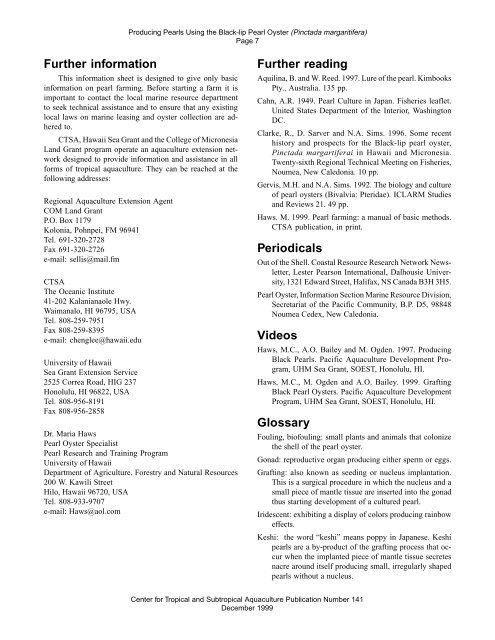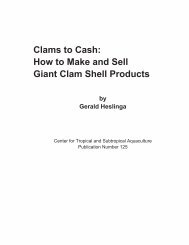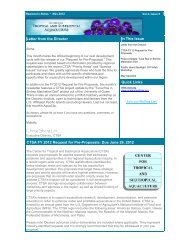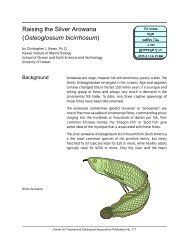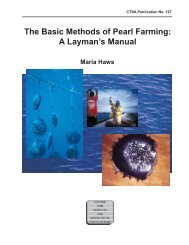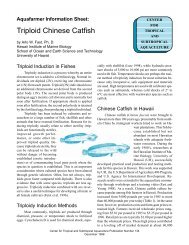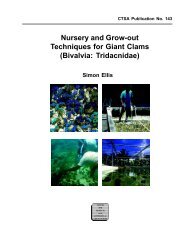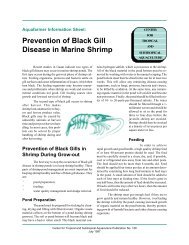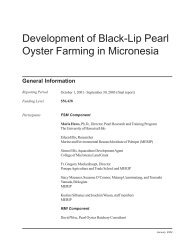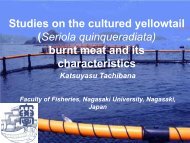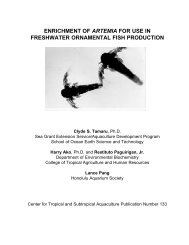Producing Pearls Using the Black-lip Pearl Oyster - CTSA
Producing Pearls Using the Black-lip Pearl Oyster - CTSA
Producing Pearls Using the Black-lip Pearl Oyster - CTSA
Create successful ePaper yourself
Turn your PDF publications into a flip-book with our unique Google optimized e-Paper software.
<strong>Producing</strong> <strong><strong>Pearl</strong>s</strong> <strong>Using</strong> <strong>the</strong> <strong>Black</strong>-<strong>lip</strong> <strong>Pearl</strong> <strong>Oyster</strong> (Pinctada margaritifera)Page 7Fur<strong>the</strong>r informationThis information sheet is designed to give only basicinformation on pearl farming. Before starting a farm it isimportant to contact <strong>the</strong> local marine resource departmentto seek technical assistance and to ensure that any existinglocal laws on marine leasing and oyster collection are adheredto.<strong>CTSA</strong>, Hawaii Sea Grant and <strong>the</strong> College of MicronesiaLand Grant program operate an aquaculture extension networkdesigned to provide information and assistance in allforms of tropical aquaculture. They can be reached at <strong>the</strong>following addresses:Regional Aquaculture Extension AgentCOM Land GrantP.O. Box 1179Kolonia, Pohnpei, FM 96941Tel. 691-320-2728Fax 691-320-2726e-mail: sellis@mail.fm<strong>CTSA</strong>The Oceanic Institute41-202 Kalanianaole Hwy.Waimanalo, HI 96795, USATel. 808-259-7951Fax 808-259-8395e-mail: chenglee@hawaii.eduUniversity of HawaiiSea Grant Extension Service2525 Correa Road, HIG 237Honolulu, HI 96822, USATel. 808-956-8191Fax 808-956-2858Dr. Maria Haws<strong>Pearl</strong> <strong>Oyster</strong> Specialist<strong>Pearl</strong> Research and Training ProgramUniversity of HawaiiDepartment of Agriculture, Forestry and Natural Resources200 W. Kawili StreetHilo, Hawaii 96720, USATel. 808-933-9707e-mail: Haws@aol.comFur<strong>the</strong>r readingAquilina, B. and W. Reed. 1997. Lure of <strong>the</strong> pearl. KimbooksPty., Australia. 135 pp.Cahn, A.R. 1949. <strong>Pearl</strong> Culture in Japan. Fisheries leaflet.United States Department of <strong>the</strong> Interior, WashingtonDC.Clarke, R., D. Sarver and N.A. Sims. 1996. Some recenthistory and prospects for <strong>the</strong> <strong>Black</strong>-<strong>lip</strong> pearl oyster,Pinctada margartiferai in Hawaii and Micronesia.Twenty-sixth Regional Technical Meeting on Fisheries,Noumea, New Caledonia. 10 pp.Gervis, M.H. and N.A. Sims. 1992. The biology and cultureof pearl oysters (Bivalvia: Pteridae). ICLARM Studiesand Reviews 21. 49 pp.Haws. M. 1999. <strong>Pearl</strong> farming: a manual of basic methods.<strong>CTSA</strong> publication, in print.PeriodicalsOut of <strong>the</strong> Shell. Coastal Resource Research Network Newsletter,Lester Pearson International, Dalhousie University,1321 Edward Street, Halifax, NS Canada B3H 3H5.<strong>Pearl</strong> <strong>Oyster</strong>, Information Section Marine Resource Division,Secretariat of <strong>the</strong> Pacific Community, B.P. D5, 98848Noumea Cedex, New Caledonia.VideosHaws, M.C., A.O. Bailey and M. Ogden. 1997. <strong>Producing</strong><strong>Black</strong> <strong><strong>Pearl</strong>s</strong>. Pacific Aquaculture Development Program,UHM Sea Grant, SOEST, Honolulu, HI.Haws, M.C., M. Ogden and A.O. Bailey. 1999. Grafting<strong>Black</strong> <strong>Pearl</strong> <strong>Oyster</strong>s. Pacific Aquaculture DevelopmentProgram, UHM Sea Grant, SOEST, Honolulu, HI.GlossaryFouling, biofouling: small plants and animals that colonize<strong>the</strong> shell of <strong>the</strong> pearl oyster.Gonad: reproductive organ producing ei<strong>the</strong>r sperm or eggs.Grafting: also known as seeding or nucleus implantation.This is a surgical procedure in which <strong>the</strong> nucleus and asmall piece of mantle tissue are inserted into <strong>the</strong> gonadthus starting development of a cultured pearl.Iridescent: exhibiting a display of colors producing rainboweffects.Keshi: <strong>the</strong> word “keshi” means poppy in Japanese. Keshipearls are a by-product of <strong>the</strong> grafting process that occurwhen <strong>the</strong> implanted piece of mantle tissue secretesnacre around itself producing small, irregularly shapedpearls without a nucleus.Center for Tropical and Subtropical Aquaculture Publication Number 141December 1999


